 Bigger-Picture
Bigger-Picture
Windows on the world
Pacific Journal New
Zealand
Harvey
ís Pacific Journal ~ 2007
6.
Rarotonga to
Auckland
,
New Zealand
Depart 10.15;
Arrive 13.35
Air New
Zealand
Flight NZ023. Flying time 4 hours.
Distance 3010 km
Monday 5 March
I have set the alarm for 7.00am and requested a wake-up call, but we are out of
bed before either. We leave the
hotel at 8.15 and the plane leaves on time.
We leave
Rarotonga
on the morning of the health inspection. Every
household is checked to weed out breeding grounds for dengue-carrying
mosquitoes. Empty coconut shells
lying around in the backyard collecting puddles of rainwater are not allowed.
We are given a snack, and we read. I
finish Morris Westís The Navigator,
a Polynesian journey into the Pacific and into the human condition.
Some experts believe that the Polynesian explorers couldnít navigate,
that they simply drifted until they happened upon an island.
Reading this novel I have no doubt that they could navigate.
We cross the international date line, and suddenly itís tomorrow.
Tuesday 6 March
It takes a while to clear customs in
Auckland
. I mention cricket to the
immigration officer (the world cup is just about to start in the
West Indies
) but he follows football and is a Tottenham fan.
We collect the car we hired back in the
UK
and off we go, roadmaps at the ready.
Mercure Hotel,
Customs Street
,
Auckland
,
New Zealand
Locataion: 36:53:00S 174.45.00E (GMT +13) NZ$2.80
= £1
The roads are wide and well signed, the suburbs are green and spacious, and we
donít notice any slums or shanties. The
shopping streets downtown look affluent. We
lose our way once, but weíre soon checking into the hotel, where we have
glimpses of the harbour from our room on the seventeenth floor.
We have a drink and then Sue is ready to sample the shops and I want to
look at the harbour. We do both, in
bright sunshine, and the waterfront reminds me of
Portsmouth
, albeit on a grander scale. Across
the water are lots of trees and what looks like more suburbs, but we canít
tell whether there are islands or this is the other side of the bay.
We go back to the hotel to get changed, and then choose a waterfront
restaurant at random. Earlier it had
been hot, but now we are sitting outdoors in the shade and the breeze feels
cold. We both enjoy the meal (I have
a fish called terrakihi) but we are glad to forego our dessert and leave our
windy table.
Wednesday 7 March
Sue has a disturbed night, but on the whole she is sleeping more hours than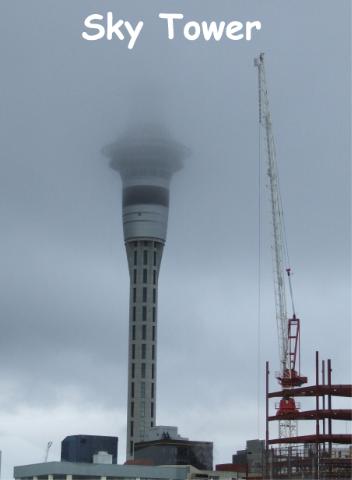 she has for years. Breakfast is on
the 12th floor, with splendid views over the city and harbour.
As we eat we watch the ferries coming and going, and the rain clouds
scudding across the bay. Sue makes a
waffle, and feels rather pleased with herself.
We check out at 9.30 and within a few minutes we pick up Highway 1
heading north over the harbour bridge. Again,
the suburbs are attractive, gradually giving way to green, undulating
countryside. In parts it is not
unlike
Britain
, except for the profusion of tree ferns. We
even see a herd of Belted Galloways, more cows together than we have ever seen
in Dumfries and
Galloway
. The rain is intermittent, but one
shower is torrential. We stop for
lunch at Whangarei. We drive round
the industrial areas for a while before we find the town centre, but when we do
itís very pleasant. I am struck by
the notices in several shops informing would-be truants that the police or the
truant officer will be called if students are loitering during school hours.
We donít know how effective the system might be, but it seems more
sensible than the latest approach adopted in the
UK
, whereby mothers of truants are threatened with imprisonment.
she has for years. Breakfast is on
the 12th floor, with splendid views over the city and harbour.
As we eat we watch the ferries coming and going, and the rain clouds
scudding across the bay. Sue makes a
waffle, and feels rather pleased with herself.
We check out at 9.30 and within a few minutes we pick up Highway 1
heading north over the harbour bridge. Again,
the suburbs are attractive, gradually giving way to green, undulating
countryside. In parts it is not
unlike
Britain
, except for the profusion of tree ferns. We
even see a herd of Belted Galloways, more cows together than we have ever seen
in Dumfries and
Galloway
. The rain is intermittent, but one
shower is torrential. We stop for
lunch at Whangarei. We drive round
the industrial areas for a while before we find the town centre, but when we do
itís very pleasant. I am struck by
the notices in several shops informing would-be truants that the police or the
truant officer will be called if students are loitering during school hours.
We donít know how effective the system might be, but it seems more
sensible than the latest approach adopted in the
UK
, whereby mothers of truants are threatened with imprisonment.
Duke of Marlborough Hotel, Russell,
Bay of Islands
,
New Zealand
We continue north. Knowing that we
donít have much further to go, I decide weíll take the
Old Russell Road
by the coast rather than queue for the car ferry at Opua.
Itís a bad choice. The road
is pretty, but narrow, twisting and up and down.
It is slow going and seems to take forever, and by now the sun is out and
itís hot. We alternate between the
heat and the aircon. Itís a long
time before we start to have glimpses of the sea, but when we do the views are
stunning: turquoise bays, sandy beaches, inlets, cliffs, islands; just our kind
of coastline. When we eventually
reach Russell it doesnít quite match some of the views we have passed, but it
is very attractive for all that. The
town itself is like a miniature version of
Camden
,
Maine
, and the hotel is a grand old building (well, this version was built in 1933
actually) with verandas on the edge of the harbour.
The original Duke of Marlborough, built in 1827, was granted the first
liquor licence issued in
New Zealand
when it became part of the
British Empire
in 1840: licence No. 1. Our
room is spacious, with a big window looking out on the harbour, but there is no
air conditioning and the ceiling fan is not up to the task of countering the
heat from the sun all afternoon. Sue
is whacked from the journey and sleeps, notwithstanding the heat.
I start my new book, Great Tales
from New Zealand History by Gordon McLauchlan.
It has over 40 short factual stories which I hope will help to clear up
my almost-total ignorance of NZ. When
Sue comes round we take a stroll along the waterfront, back through the town,
and have dinner at the hotel bistro on the veranda as the sun sets over the
Bay
of
Islands
. We are out of the wind here, and
even when the sun disappears the temperature is pleasant.
Thursday 8 March
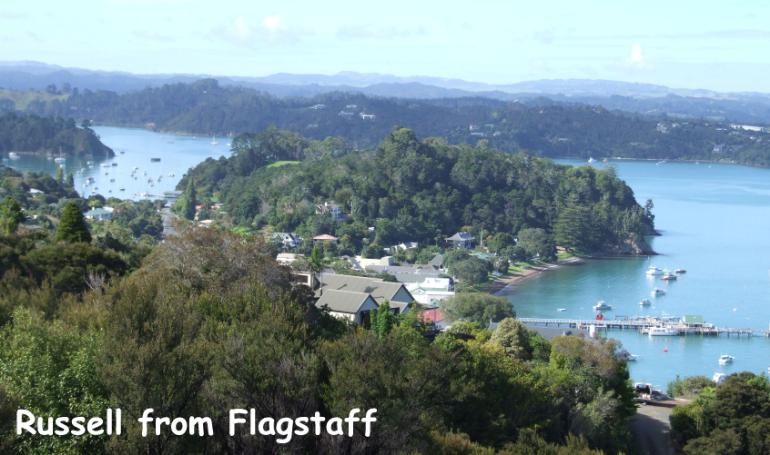 Sue wants to check her emails and I want to explore, so after breakfast we book
a tour for the afternoon and go our separate ways.
I take the walk up
Sue wants to check her emails and I want to explore, so after breakfast we book
a tour for the afternoon and go our separate ways.
I take the walk up
Telegraph Hill, not far but quite steep. The
views are spectacular: back down to Russell and the harbour; on to the headland
of Tapeka; and out into the Bay. This
is where the Union Flag was raised following the signing of the Treaty of
Waitangi in 1840 but, disillusioned with the way things worked out, Hone Heke
(first chief to sign the treaty) cut down the flagstaff four times.
The British didnít see the warning signs and in 1845 found themselves
fighting the Maori in the
Battle
for Kororareka. Kororareka was the
old name for Russell, much more romantic until you discover that it means sweet
blue penguin (as in soup).
Back in Russell I bump into Sue (itís a small town) and we buy a snack for a
picnic lunch. I also buy an
Australian bush hat (my panama seems totally inappropriate here) and some ear
drops to try to clear up the deafness in my left ear that has persisted since
the flight from
Tahiti
.. Then we separate again, and I go
to see the church, the oldest in
New Zealand
, with bullet holes in the wooden walls from the
Battle
of 1845. The largest memorial in
the churchyard is to a Maori chief, Tamati Waka Nene, who worked for peace and
unity between the Maori and the Pakeha (the British) for over 30 years.
His portrait is inside the church. I
donít remember seeing any similar tribute to an Aborigine in
Australia
, and I start thinking that integration between residents and settlers in
New Zealand
must have been better than in most countries I have visited.
Sue has had a nap at the hotel, and at 1 oíclock we set off for a cruise round
the
Bay
of
Islands
. The boat is a large, fast
catamaran, and we move serenely out of
Russell
Harbour
in glorious sunshine, but the man providing the commentary warns of a Pacific
swell as we get further out. Sue and
I are tucking into our lunch as he gives instructions on what to do if we are
sea sick. No-one else is eating and
we wonder if we are pushing our luck. But
the scenery is stunning: islands, beaches, bays, hills, all bathed in sunshine,
the 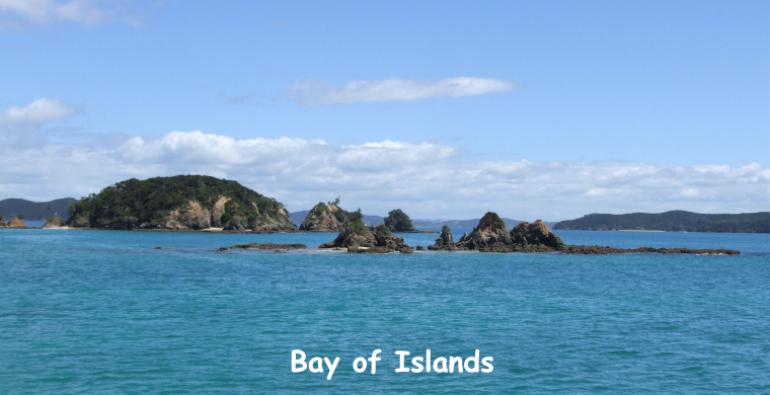 overall effect as beautiful as we have seen anywhere in the world.
There are several large shoals of fish on the surface, some being farmed
by sea birds. We go right out to
Cape
Brett
, where there is a lighthouse, abandoned in the 1970ís.
When it was manned supplies were handed ashore in baskets (boats
couldnít land) and then winched up a steep railway by horse power: one horse
walking round and round a capstan. Near
the lighthouse is a small basalt island with an arch just large enough for a
boat to pass through. By now we are
in the gentle Pacific swell that we had been promised (although no-one is sick)
and as we approach the ĎHole in the Rockí I remember how difficult it was to
bring my motorboat into its Derwentwater boathouse when there was a lake swell
and an onshore breeze. In fact, when
we get into the arch there is clear water on either side, and the manoeuvre was
probably easier than my boathouse. We
pass right through the arch, and then as we watch the next boat coming through
we get a call from our sister boat: dolphins have been spotted.
They are about twenty minutes away, so off we go, the catamaran moving at
speed for the first time. Sure
enough, there are about a dozen dolphins, including one baby.
They swim alongside the boat, under the boat, jump and dive; all in all
they put on an amazing impromptu display, but most of our photographs are of
disappearing tails.
overall effect as beautiful as we have seen anywhere in the world.
There are several large shoals of fish on the surface, some being farmed
by sea birds. We go right out to
Cape
Brett
, where there is a lighthouse, abandoned in the 1970ís.
When it was manned supplies were handed ashore in baskets (boats
couldnít land) and then winched up a steep railway by horse power: one horse
walking round and round a capstan. Near
the lighthouse is a small basalt island with an arch just large enough for a
boat to pass through. By now we are
in the gentle Pacific swell that we had been promised (although no-one is sick)
and as we approach the ĎHole in the Rockí I remember how difficult it was to
bring my motorboat into its Derwentwater boathouse when there was a lake swell
and an onshore breeze. In fact, when
we get into the arch there is clear water on either side, and the manoeuvre was
probably easier than my boathouse. We
pass right through the arch, and then as we watch the next boat coming through
we get a call from our sister boat: dolphins have been spotted.
They are about twenty minutes away, so off we go, the catamaran moving at
speed for the first time. Sure
enough, there are about a dozen dolphins, including one baby.
They swim alongside the boat, under the boat, jump and dive; all in all
they put on an amazing impromptu display, but most of our photographs are of
disappearing tails. 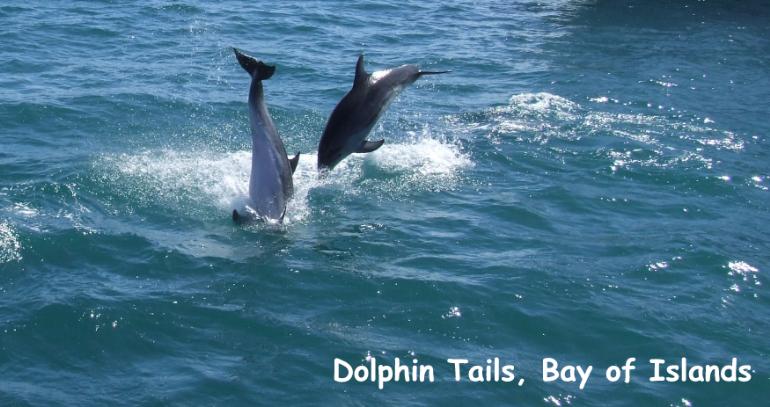 This
is a camcorder activity, and we donít manage to capture one jump between us.
The crew are excited by the baby, and they tell us that there is a high
infant mortality rate for dolphins. They
need to maintain a body temperature similar to ours, but until they have
developed a protective layer of blubber they are vulnerable to hypothermia.
They need feeding constantly (up to twenty times an hour) and if one dies
it has been known for the mother to keep the dead baby with her for days,
balanced on her nose, refusing to abandon it until the body starts to decompose.
When there are babies, boats must not stay too long and no-one is allowed
to swim with them. We are
entertained and sobered.
This
is a camcorder activity, and we donít manage to capture one jump between us.
The crew are excited by the baby, and they tell us that there is a high
infant mortality rate for dolphins. They
need to maintain a body temperature similar to ours, but until they have
developed a protective layer of blubber they are vulnerable to hypothermia.
They need feeding constantly (up to twenty times an hour) and if one dies
it has been known for the mother to keep the dead baby with her for days,
balanced on her nose, refusing to abandon it until the body starts to decompose.
When there are babies, boats must not stay too long and no-one is allowed
to swim with them. We are
entertained and sobered.
Back at Russell we have a hot drink and then wander round town again.
We book our evening meal at
Kamakura
, on The Strand near Dukeís. I
have a (
New Zealand
) lamb rack and Sue has vegetarian. We
both enjoy it, but although itís expensive itís not very substantial and Sue
heads off to buy a bar of chocolate whilst I sit with my coffee.
Whilst we eat the sun falls behind cloud but eventually re-emerges just
above the horizon for a somewhat subdued sunset.
Friday 9 March
After breakfast I go to the internet cafť (actually a charity shop) to check
emails, and then we catch the ferry to Paihia.
There is more cloud about today and itís cooler, but still very
pleasant on the water. We look round
the tourist shops and have lunch at a restaurant on the waterís edge.
Sue sees two meals being sent back, and ours arenít exciting, and too
late we realise we are in the wrong place. We
enquire how to get to the Treaty Grounds and discover that itís a half-hour
walk each way. Sue doesnít fancy
that, but as we head for the taxi rank we notice a rather exotic looking vehicle
called the Paihia Tuk Tuk Shuttle Service, and we are taken over the river to
Waitangi for $4 each. We arrive just
in time for the 1.30 guided tour, which we share with two other English couples.
One of the Englishmen insists on asking questions which we feel are in
poor taste, but our guide displays all the dignity, grace and control that one
would expect from a Maori who can trace his ancestry back to the first canoe.
Some Europeans argue that
New Zealand
was settled by a fleet of canoes, but our guide insists that there never was a
ďgreat fleetĒ. He tells us that
over several centuries a number of canoes made the journey from the legendary
(or mythical?) Maori home on the
island
of
Hawaiki
. Each canoe (or waka)
was capable of holding up to 200 people, and we are shown one built in modern
times. In fact, our guideís
great-grandfather worked on it. 35
metres long, it consists of three giant Kauri trees, cut into planks and fit
together when the wood was still green, so that as the planks season and shrink
the waka becomes watertight without
the need for caulking. When the
third tree was cut it remained stubbornly standing until prayers were said,
whereupon it crashed to the ground and the jubilant workers launched into an
impromptu haka.
The waka is in a purpose-built whare
(house) near the beach where Captain William Hobson landed in 1840 with
instructions to make a treaty with the Maori, and we follow the path he took up
to the small house where James Busby lived as ďBritish ResidentĒ.
Busby had been chief representative of the British Government since 1833,
charged with maintaining peace but without any of the powers he would have had
as Governor. He acted mainly as
mediator, and in 1835 he hosted a gathering of northern chiefs who signed the
Declaration of the Independence of New Zealand.
The newly independent state could not maintain law and order, and so many
of the chiefs were prepared to relinquish freedom for the protection of the
British Empire
. We approach the house across a
large lawn, on which the draft treaty had been read to the hundreds of Maori and
scores of European. The document had
been drafted by Busby and Hobson and translated by Williams, the missionary,
none of them legal or constitutional experts.
The Maori debated it all day and into the night, and 43 chiefs signed an
amended version the following day. Our
guide believes that although flawed in detail the treaty still reads well as a
whole and resulted in the Maori and Pakeha
becaming one people.
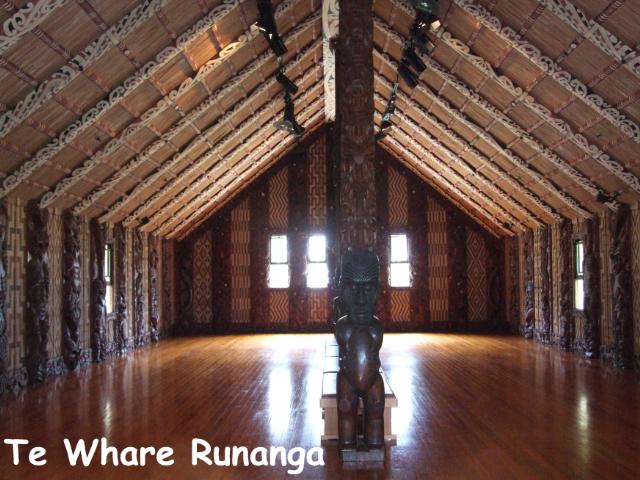 Busbyís house is now known as the Treaty House, although the signing took
place where the flagstaff now stands. Nearby
stands the Whare Runanga, a ceremonial meeting house erected to mark the
centenary celebrations in 1940. It
is splendid. The whole of the
interior is carved and woven to represent the entire story of the Maori, just as
the carved tattoos on the face of a warrior tell his story.
Because it is not an actual meeting house we are allowed to take
photographs, but although it might not be the real thing we still find it an
emotional experience. We go back to
the visitorsí centre for some traditional dancing and singing, including the
haka made famous by the All Blacks. One
of the songs is familiar and beautiful. Billy
Connelly sang it when he came to the
Bay
of
Islands
on his World Tour of New Zealand.
Busbyís house is now known as the Treaty House, although the signing took
place where the flagstaff now stands. Nearby
stands the Whare Runanga, a ceremonial meeting house erected to mark the
centenary celebrations in 1940. It
is splendid. The whole of the
interior is carved and woven to represent the entire story of the Maori, just as
the carved tattoos on the face of a warrior tell his story.
Because it is not an actual meeting house we are allowed to take
photographs, but although it might not be the real thing we still find it an
emotional experience. We go back to
the visitorsí centre for some traditional dancing and singing, including the
haka made famous by the All Blacks. One
of the songs is familiar and beautiful. Billy
Connelly sang it when he came to the
Bay
of
Islands
on his World Tour of New Zealand.
We have a drink and then I go back to the Treaty House to look inside.
The House and Grounds were granted to the nation in 1932, in time for the
centenary celebrations to be organised, which some 10,000 people attended.
Although forgotten about and neglected for much of the previous 100
years, Waitangi is now regarded as the birthplace of
New Zealand
. We walk back into Paihia and take
the ferry over to Russell, the erstwhile lawless whaling town (Hell-hole of the
Pacific) that the treaty was designed to clean up.
It worked. Russell today is
as genteel as an English spa, spoilt only (for me) by the all-pervading smell of
cooking oil from the various cafťs and restaurants.
We eat at Dukes and go to our bedroom, situated over the kitchens, and
the oily cooking smells drift up and in through our open bathroom window.
Saturday 10 March
We had thought about driving up to 90
Mile
Beach
, although we know that rental cars are not allowed on the beach itself, but
Sue is wilting under the pressure and doesnít want to spend the day in the
car. She decides she will stay in
town and I take a walk up Flagstaff Hill and down the other side to Tapeka,
about three miles away near the end of the peninsula.
Itís a lovely little spot, with perhaps 100 houses with well-tended
gardens. Thereís a beach on one
side, with the calm waters of the bay, and rough water on the other side of the
isthmus, with waves breaking on the rocks. I
walk back up the hill and go back to Russell through Kororareka Point Scenic
Reserve. Itís a Kiwi Zone, which
means no dogs without leads. The
birds are declining in numbers as their natural habitat shrinks, and being
flightless they are particularly vulnerable to dogs.
No sign of Kiwis, or blue penguins. The
path winds through dense forest, with tree ferns much in evidence, and drops
down to
Watering
Bay
. At low tide you can walk into
Russell on the rocky beach, but not now, and I have to climb part way up the
hill again.
Back at the hotel I sit on the beach and wait for Sue, but instead I get a text
message: ďCome to the grass square ASAP.Ē
Mildly alarmed (has she had an accident?) I hurry over to find a small
festival taking place. I have missed the parade but I see Sue and we watch young children in traditional dress and
painted tattoos dancing and singing. We
are enchanted, and we have a snack there so we can go on watching the
performances. On the way back to the
hotel, but away from the main festival, we see another dance troupe in
traditional dress. They are all
white children, and several of the white mothers join in, swinging pom-poms,
perhaps familiar with the routines from their own childhood.
It dawns on us that the first set of dancers were mostly coloured.
Maori in one part of town, Pakeha
in another. Hmm.
Perhaps the ďOne People, One NationĒ concept doesnít quite filter
through to suburbia. Nevertheless,
it is good to see Maori traditions being embraced so whole-heartedly.
the parade but I see Sue and we watch young children in traditional dress and
painted tattoos dancing and singing. We
are enchanted, and we have a snack there so we can go on watching the
performances. On the way back to the
hotel, but away from the main festival, we see another dance troupe in
traditional dress. They are all
white children, and several of the white mothers join in, swinging pom-poms,
perhaps familiar with the routines from their own childhood.
It dawns on us that the first set of dancers were mostly coloured.
Maori in one part of town, Pakeha
in another. Hmm.
Perhaps the ďOne People, One NationĒ concept doesnít quite filter
through to suburbia. Nevertheless,
it is good to see Maori traditions being embraced so whole-heartedly.
Later in the afternoon I go to the amphitheatre by the visitorsí centre to
watch the Russell Theatre Group telling the story of the
Battle
for Kororareka in 1845, which took place following the breaking of the
flagstaff on Maiki Hill for the fourth time.
The actors, in costume, read eye-witness accounts of the day.
It doesnít reflect well on the Pakeha,
who withdrew to their ships and watched the victorious Maori burn the houses
(but not the church) from a safe distance. Order
was eventually restored but the Maori had made their point, and the British
became more circumspect in their dealings. There
are probably a score or so of actors, but only one is Maori.
We have fish & chips on the veranda in front of the hotel and drive over to
Tapeka in the evening sunlight. Then
itís back to the room to pack. Without
air-conditioning itís hot.
Sunday 11 March
We wake at 6.30, before the alarm, and after a quick breakfast weíre on the
road before 8.00. It took us a lot
longer to get to Russell, but we think it should take us three and a half hours
to get to
Auckland
. We need to check in by 12.30 so
we donít have much leeway for hold-ups. Itís
Sunday morning, and weíre not sure of the ferry timings at Opua, but a boat is
pulling in as we arrive at the terminal and we cross in few minutes.
Itís a good run all the way apart from a couple of heavy showers and we
arrive at the airport at 11.00. There
are the usual preliminaries: fill up the car with petrol, return the car, check
in, pay the departure tax, have a snack; and then we take off on time at 14.35.
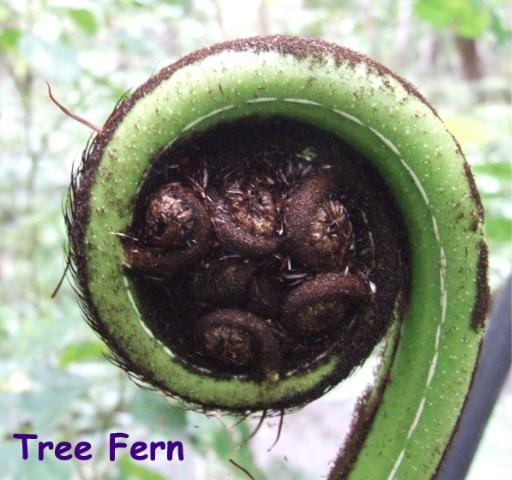 Next
leg:
Next
leg:
7.
Auckland
to Brisbane
Back
to Itinerary
 Bigger-Picture
Bigger-Picture Bigger-Picture
Bigger-Picture she has for years. Breakfast is on
the 12th floor, with splendid views over the city and harbour.
As we eat we watch the ferries coming and going, and the rain clouds
scudding across the bay. Sue makes a
waffle, and feels rather pleased with herself.
We check out at 9.30 and within a few minutes we pick up Highway 1
heading north over the harbour bridge. Again,
the suburbs are attractive, gradually giving way to green, undulating
countryside. In parts it is not
unlike
she has for years. Breakfast is on
the 12th floor, with splendid views over the city and harbour.
As we eat we watch the ferries coming and going, and the rain clouds
scudding across the bay. Sue makes a
waffle, and feels rather pleased with herself.
We check out at 9.30 and within a few minutes we pick up Highway 1
heading north over the harbour bridge. Again,
the suburbs are attractive, gradually giving way to green, undulating
countryside. In parts it is not
unlike  Sue wants to check her emails and I want to explore, so after breakfast we book
a tour for the afternoon and go our separate ways.
I take the walk up
Sue wants to check her emails and I want to explore, so after breakfast we book
a tour for the afternoon and go our separate ways.
I take the walk up  overall effect as beautiful as we have seen anywhere in the world.
There are several large shoals of fish on the surface, some being farmed
by sea birds. We go right out to
overall effect as beautiful as we have seen anywhere in the world.
There are several large shoals of fish on the surface, some being farmed
by sea birds. We go right out to  This
is a camcorder activity, and we donít manage to capture one jump between us.
The crew are excited by the baby, and they tell us that there is a high
infant mortality rate for dolphins. They
need to maintain a body temperature similar to ours, but until they have
developed a protective layer of blubber they are vulnerable to hypothermia.
They need feeding constantly (up to twenty times an hour) and if one dies
it has been known for the mother to keep the dead baby with her for days,
balanced on her nose, refusing to abandon it until the body starts to decompose.
When there are babies, boats must not stay too long and no-one is allowed
to swim with them. We are
entertained and sobered.
This
is a camcorder activity, and we donít manage to capture one jump between us.
The crew are excited by the baby, and they tell us that there is a high
infant mortality rate for dolphins. They
need to maintain a body temperature similar to ours, but until they have
developed a protective layer of blubber they are vulnerable to hypothermia.
They need feeding constantly (up to twenty times an hour) and if one dies
it has been known for the mother to keep the dead baby with her for days,
balanced on her nose, refusing to abandon it until the body starts to decompose.
When there are babies, boats must not stay too long and no-one is allowed
to swim with them. We are
entertained and sobered. Busbyís house is now known as the Treaty House, although the signing took
place where the flagstaff now stands. Nearby
stands the Whare Runanga, a ceremonial meeting house erected to mark the
centenary celebrations in 1940. It
is splendid. The whole of the
interior is carved and woven to represent the entire story of the Maori, just as
the carved tattoos on the face of a warrior tell his story.
Because it is not an actual meeting house we are allowed to take
photographs, but although it might not be the real thing we still find it an
emotional experience. We go back to
the visitorsí centre for some traditional dancing and singing, including the
haka made famous by the All Blacks. One
of the songs is familiar and beautiful. Billy
Connelly sang it when he came to the
Busbyís house is now known as the Treaty House, although the signing took
place where the flagstaff now stands. Nearby
stands the Whare Runanga, a ceremonial meeting house erected to mark the
centenary celebrations in 1940. It
is splendid. The whole of the
interior is carved and woven to represent the entire story of the Maori, just as
the carved tattoos on the face of a warrior tell his story.
Because it is not an actual meeting house we are allowed to take
photographs, but although it might not be the real thing we still find it an
emotional experience. We go back to
the visitorsí centre for some traditional dancing and singing, including the
haka made famous by the All Blacks. One
of the songs is familiar and beautiful. Billy
Connelly sang it when he came to the  the parade but I see Sue and we watch young children in traditional dress and
painted tattoos dancing and singing. We
are enchanted, and we have a snack there so we can go on watching the
performances. On the way back to the
hotel, but away from the main festival, we see another dance troupe in
traditional dress. They are all
white children, and several of the white mothers join in, swinging pom-poms,
perhaps familiar with the routines from their own childhood.
It dawns on us that the first set of dancers were mostly coloured.
Maori in one part of town, Pakeha
in another. Hmm.
Perhaps the ďOne People, One NationĒ concept doesnít quite filter
through to suburbia. Nevertheless,
it is good to see Maori traditions being embraced so whole-heartedly.
the parade but I see Sue and we watch young children in traditional dress and
painted tattoos dancing and singing. We
are enchanted, and we have a snack there so we can go on watching the
performances. On the way back to the
hotel, but away from the main festival, we see another dance troupe in
traditional dress. They are all
white children, and several of the white mothers join in, swinging pom-poms,
perhaps familiar with the routines from their own childhood.
It dawns on us that the first set of dancers were mostly coloured.
Maori in one part of town, Pakeha
in another. Hmm.
Perhaps the ďOne People, One NationĒ concept doesnít quite filter
through to suburbia. Nevertheless,
it is good to see Maori traditions being embraced so whole-heartedly.  Next
leg:
Next
leg: